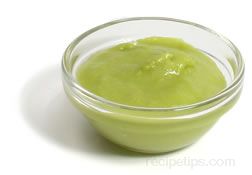Similar Content to: Wasabi Peas

When buying Wasabi, choose roots or leaves that are uniform in color, unwilted, not damaged or blemished, and are firm to the touch. To prepare, remove the leaves and stems, wash the root to remove any dirt or blemishes. If the leaves are to be used as salad greens or as a garnish, wash the leaves as well. Then, using a grater such as a sharkskin grater favored for the smooth result it provides or a fine bladed grater, remove small bits of the root with a circular grating motion. Let the grated pieces fall into and form a small pile to allow the entire amount to become warmed to room temperature in order to develop the sweet and spicy hot flavor present in the root. Since the flavor decreases quickly, the grated Wasabi should be used within a half hour of grating. When eaten, fresh Wasabi will first have an intense hot taste that quickly decreases, leaving a sweet and mildly spicy flavor. Fresh Wasabi is not often available, so the alternative is to use a Wasabi paste or ground Wasabi that can be used to make the spicy paste.
When Wasabi is purchased in powdered form, it is mixed with water to produce a thick paste-like condiment. The ground version of Wasabi typically contains very little of the Wasabi plant, but may contain dried Wasabi leaves. Most often, ground Wasabi is basically a powder made from horseradish, mustard powder, cornstarch, food coloring, and possibly a little fresh Wasabi. Since fresh Wasabi is not always readily available, it is not uncommon to find that a blend of horseradish and green food coloring has been combined that is referred to as "Wasabi" or Wasabi Paste on a menu or ingredient listing. Wasabi Paste labeled as "Prepared" Wasabi is a mixture of horseradish, artificial flavor, artificial coloring, and miscellaneous ingredients. Wasabi Paste labeled as "100% Real Wasabi" will typically be the genuine ingredients using Wasabi root and no horseradish. However, to be sure, check the listing of ingredients on the product label.
Fresh Wasabi should wrapped in a damp paper towel and refrigerated where it can remain stored for 3 to 4 weeks. Keep the fresh root washed weekly and remove blemishes or darkened areas before grating. Wasabi paste can be kept unopened for 2 months, or opened and stored in a refrigerator for 1 month or if frozen, stored for 18 months or slightly longer.
Wasabi products are most often used in raw fish dishes, such as sushi or sashimi as well as for serving with various varieties of cooked fish, noodle dishes, salads, and for making into sauces, dips or marinades. It is a common flavoring for soba and udon noodle dishes as well as for meats, seafoods, and dim sum. Other ingredients such as soy sauce (Wasabi-joyu) or rice wine may be blended with fresh Wasabi or Wasabi paste to provide added flavor. Wasabi paste and powder is also referred to as Japanese horseradish.







